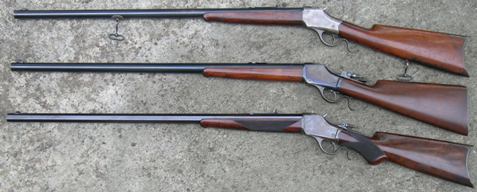I have a number of stocks and forearms that I believe are for Model 1885 Single Shot Lowalls. At a recent event, the discussion came up as to whether the stocks and forearms of Hiwalls and Lowalls were interchangeable? So far, I have been unable to determine the answer to that that question to my satisfaction. I have a book on Winchesters, by Geo. Madis, but I have been unable to find any such reference. Does anyone know or can you point me to definitive answer. I do not have a Hiwall in my possession which I can match up to what I have. Thanks for your help
The first thing that needs to be discussed & clarified, is that not all low-wall Model 1885 rifles were created equally. Specifically, there were three different low-wall frame types, and years ago I wrote the following descriptions summarizing each type;
Low-wall frame variations;
The low-wall frame was made in three distinctly different variations, with the Second Variation being the most common by a wide margin. The following paragraphs provide a brief physical description of the three low-wall frame variations, with the approximate serial number and production timeframe for each;
First Variation:
Features a receiver frame with milled sides (paneled) just like the vast majority of the high-walls, and it has a full height breech block that is not scalloped (contour milled) to match the upper frame. It will always be found with a flat-spring action. Essentially, it is a high-wall with the rear portion of the frame (behind the breech block) milled down. The frame ring is threaded for the standard .825” small shank barrel. It could be threaded for a large shank (.935”) barrel if special ordered with a No. 3 barrel, but it is very rarely encountered. The First variation low-walls were made with a No. 1 barrel as standard, with a No. 2 barrel available as a special order option. The top of the frame ring is most often found with a milled longitudinal groove that allowed for a better sight picture when a No. 1 barrel was used. When a No. 2 barrel was special ordered, the longitudinal groove was omitted. The serial number range for the First Type low-wall is from circa 2250 to circa 17,500 (early 1886 to late 1887). Because it is essentially a milled down high-wall frame, the stocks, and most internal action parts are interchangeable. The only notable difference is the upper and lower tang thickness, which is slightly thinner than a high-wall. A high-wall lower tang will not fit without relieving the tang channels in the buttstock, but a First variation low-wall lower tang will slide right in a high-wall frame.
Second Variation:
Features a flat-sided frame with a scalloped (contoured milled) breech block to match the upper frame. In order to make the Second variation low-wall frame trimmer, and to lighten the overall weight, Winchester eliminated the flared sections of the frame. This made the front and rear of the frame considerably thinner than the First Variation. The frame ring was threaded for the .825” small shank barrel only, and the No. 1 barrel was standard. As with the First Variation, the frame ring is milled with a longitudinal groove when a No. 1 barrel is present, and the groove was omitted when a No. 2 barrel was special ordered. The flat-spring action was used exclusively until March of 1908, then used intermittently until being completely phased out by the coil-spring action in early 1909. Shortly after the coil-spring was introduced in early 1908, Takedown frames were offered. The serial number range for the Second Variation is from circa 16,500 to circa 125,000 (mid 1887 to January 1918). The lower tang is not interchangeable with the high-wall, or with the First and Third Variation low-wall frames. Most other internal parts will not interchange properly (at least not without considerable alteration).
Third Variation:
Found on the coil-spring action Model 87 Winder Muskets only. It has the same exact style milled sides as the First Variation low-wall frame, but with a scalloped (contour milled) breech block. The most unique feature of this variation is that they were all threaded for the large shank (.935”) barrel. The top of the frame ring was never made with the milled longitudinal groove. This third and final low-wall variation was simply a high-wall frame that was milled down, and other than the breech block, it is identical to the Second Model high-wall Winder Musket. All parts including the lower tang are interchangeable with a coil-spring action high-wall. The serial number range is from circa 119,100 to 139735 (end of production). It was never available as a Takedown.
Bert
WACA Historian & Board of Director Member #6571L

1 Guest(s)


 Log In
Log In Members
Members Home
Home

 Add Reply
Add Reply Add Topic
Add Topic Offline
Offline





